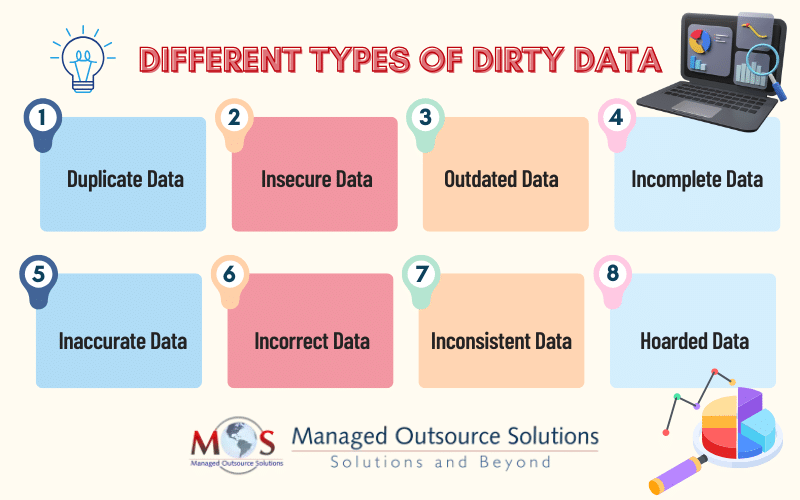Today, organizations across industries are inundated with vast amounts of data generated from various sources. This data holds the potential to unlock valuable insights, streamline operations, and drive strategic decision-making. However, the reality is that not all data is reliable or useful. Dirty data—characterized by inaccuracies, inconsistencies, duplicates, and omissions — can pose significant challenges for businesses. As data grows, proper management of it is inevitable. However, data cleansing services can ensure that all data is stored well and securely maintained.
According to Gartner, poor data costs businesses an average of $12.9 million per year. According to the McKinsey Global Institute, poor-quality data can reduce productivity by 20% and raise costs by 30%. Working with poor data has major effects, including reduced client loyalty, lost revenue, and squandered resources, as well as erroneous decision-making and missed opportunities. Dirty data can compromise customer relationships, skew analytics, and ultimately hinder a company’s growth.
What Is Dirty Data and Where Does It Come from?
Data that is flawed in some way, such as having duplicates or being out-of-date, unsecure, incomplete, inaccurate, or inconsistent, is referred to as dirty data. Misspelled addresses, missing field values, out-of-date phone numbers, and duplicate client records are a few examples of dirty data. Dirty data can seriously harm your company if you disregard it. It can have a detrimental effect on strategic choices, compromise the customer experience, and result in the distortion of business outcomes.
Dirty data can take many different forms. You need to know what generates erroneous data in order to comprehend it directly. Here are some typical causes of erroneous or contradictory data:
- Human errors: Errors are bound to occur because data entry is a repetitive and perhaps tiresome process. This could be the result of unclear instructions, inadvertent errors, or just forgetting to include some entries. Over time, these mistakes—which are frequently minor—can add up and create serious discrepancies.
- Miscommunication within the department: Interdepartmental communication or the absence of it, is another major source of dirty data. 35% of unclean data results from poor departmental communication. This occurs when data is inefficiently provided to another department. When data is transferred from one department to another, the issue of dirty data usually occurs because different departments frequently operate in data silos, each with its own methods for handling, structuring, and storing data.
- Ineffective data strategy: The organization’s inadequate data strategy for handling its data is another factor contributing to bad data. Dirty data results from human data entry at any stage, flawed data combining, or the use of crude technologies for data access, storage, or management.
- Absence of standardized procedures: Different people or groups may use different approaches or formats for the same type of data if there are no established procedures for gathering it. When various data sets are compared or integrated, this discrepancy may result in inconsistencies and mismatches.
- Inadequate data cleansing and validation: To preserve data quality, databases must be reviewed and cleaned on a regular basis. Without these safeguards, errors may continue to exist and worsen, eventually causing the quality of the data to decline.
- External sources of information: The quality of the external source must be taken into consideration while importing data from it. This external data may introduce errors or inconsistencies into the current database if proper validation isn’t done.
Types of Dirty Data and How to Clean It
- Duplicate Data: The most prevalent kind of dirty data is duplicate data. Among the data points accidentally shared with other CRM systems are repetitive leads, accounts, and contacts. Partial duplicates, which are sometimes the consequence of human error, generate more serious problems even though carbon copies are the easiest to find and eliminate. Inaccurate data recovery, ineffective personalization, unbalanced analysis, wasteful processes, overcrowded storage systems, and recurrent customer communications are all consequences of duplicate data.
How to cleanse it: Manual data cleansing is not adequate in the current situation, when companies handle massive volumes of data on a regular basis. Furthermore, partial duplicates are not always eliminated by hand cleaning. Invest in a reliable data cleansing provider that can merge or remove duplicates and identify and clean up data. It can also combine and organize redundant data according to company-specific criteria.
- Insecure Data: Security rules have changed the marketing environment due to the growth of data. Simultaneously, serious privacy concerns have strained the bonds between consumers and businesses, leading to adjustments in both legislative actions and individuals’ privacy-preserving practices. Now in effect are significant privacy and data security legislations including the CCPA and GDPR. Serious financial penalties may be imposed for data that violates these regulations or is unsecure. For example, a user might have previously submitted their information without agreeing to your privacy and data sharing policies. Serious consequences may arise from this type of unsecure data. Without proper CRM hygiene, it becomes impossible to comply with these regulations.
Not to mention the harm to the reputation of the brand. Despite public outrage, giants like Amazon and WhatsApp have already paid large fines for alleged GDPR non-compliance, totaling more than $800 million and $270 million, respectively.
How to cleanse it: Adhering to data privacy regulations can be directly aided by maintaining a clean database. Deleting useless and unsecured records from your CRM, combining duplicates for more current data, unifying your data stack and automating the lead-to-account connecting process, and putting your CRM on legally acceptable cloud software are all examples of best practices for cleaning unsafe data.
- Outdated data: Information that is important now could not be important tomorrow, and is outdated data. Analyses relying on out-of-date data are similar to driving over a ledge while using incorrect GPS data. For example, a website user obtains your resource by completing a form. In the months that follow, they become a prospect and engage with your business more, answering emails and subscribing to newsletters. But this information hasn’t been changed in your CRM.
As a result, the content you give them is still targeted at a new lead rather than one that is currently being developed. It restricts their capacity to move further down the client acquisition funnel. Job changes, corporate reorganizations or mergers, and old software systems that are unable to keep up with the quick pace of technological innovation are other causes of outdated data.
How to cleanse it: Purging and cleaning data prior to migration or system integration is the most effective method of getting rid of out-of-date information. Determining the crucial time for your company is another matter. Remove all previous data from the system. Data cleansing providers can complete this work for you in a few hours, whereas manual cleansing may take days or weeks. Use an automated tool instead.
- Incomplete Data: A record is deemed incomplete if it lacks necessary components to digest the incoming data before sales and marketing act. Sales representatives’ work is considerably more difficult when there are data gaps. Unfortunately, problems with missing data are rather common and can make it difficult to maximize the value of the information you have gathered. Consider a situation in which you have the buyer’s phone number on file but not their email address. You miss out on a big sales opportunity because you are unable to send this buyer a vital email campaign promoting your services. It’s also difficult to score leads and divide up prospects based on little information.
How to cleanse it: There are two choices for you. The first is to manually search incomplete records and add missing information. However, you’ll soon find that this strategy isn’t scalable or practical. In contrast, you can hire a data cleansing provider for identifying and rectifying dirty data, providing expertise, tools, and resources to effectively cleanse datasets.
- Inaccurate data: One of the worst types of data pollution is inaccurate data. Representatives may fill out a form accurately, but the data is erroneous or fraudulent. For instance, your representative cannot call a prospect who supplies a phony mobile number. Even worse, when accuracy is crucial, communicating with the incorrect individual might cause the entire purchasing process to be disrupted. Approximately 77% of companies concur that having erroneous data makes it more difficult for them to adjust to changes. Furthermore, 41% of sales representatives have difficulties with erroneous data. It results in inaccurate reporting and bad choices.
How to cleanse it: From the beginning, marketing and sales initiatives must leverage correct data. Thus, it’s critical to monitor this data at the point of entry and prevent it from entering the system. To increase accuracy, integrate with reliable data cleansing solutions.
- Incorrect Data: Information that is stored incorrectly or does not meet the specifications of the specified field is referred to as incorrect data. For example, a date is formatted incorrectly, a designation is placed beneath the company name field, or a text field contains a number value. This erroneous data has a number of serious problems, including poor campaign targeting, pointless communications, and a dearth of prospect insights. 39% of firms reported negative effects on the buyer experience as a result of low data quality in a B2B business ecosystem, where improving the buyer experience is a key priority. To give customers the experience they anticipate, you want to update or remove this kind of data.
How to cleanse it: To guarantee that data is accurate or legitimate, personnel should adhere to guidelines and enter data within the allowed ranges. Additionally, you can programmatically enforce the accuracy of data points by using edit checks or lookup tables.
- Inconsistent Data: Don’t confuse inconsistent and duplicate data, even though they may look the same. Data is duplicated when it is replicated exactly as it is. On the other hand, inaccurate data is not standardized and does not follow established guidelines. When the same elements appear in the system in different versions, you observe inconsistent data. For example, several formats are used to enter the same data field for the CMO, Chief of Marketing, Chief Marketing Officer, and Chief Marketing Officer. Since sales representatives must consider several factors when analyzing the same lead information, data has a negative influence on analytics and decision-making.
How to cleanse it: Using a centralized strategy is the quickest way to clear this erroneous data. Your representatives can adhere to a uniform file-naming convention that you establish. It may be challenging to manually remove incorrect data that already exists, but you may handle the heavy lifting by using a data cleansing solution for CRM.
- Hoarded Data: A huge amount of data is gathered by many businesses in order to produce important insights later on. However, the risks and issues associated with “real-life” hoarding are also present in data hoarding. Excessive data hoarding can increase storage costs and impede data transmission. Additionally, it leads to issues with data hygiene, which makes it difficult to retrieve important information for business decision-making. Various departments may require distinct data variables at times. As departments are unable to locate crucial data points in the storage of another team, it increases data storage while adversely hurting collaboration.
How to cleanse it: By concentrating on important data and keeping it in one location, businesses can prevent data hoarding. It improves teamwork by cutting down on the amount of time spent delving into analysis. Use data cleansing solutions, they can immediately clear out-of-date and hoarded data and also save time.
Maintaining high-quality data is crucial for effective decision-making and operational success. Understanding the types of dirty data and implementing effective cleansing strategies can significantly enhance data reliability and usability. By investing in data cleansing services, organizations can ensure their datasets remain accurate, complete, and valuable, ultimately leading to better insights and outcomes.





